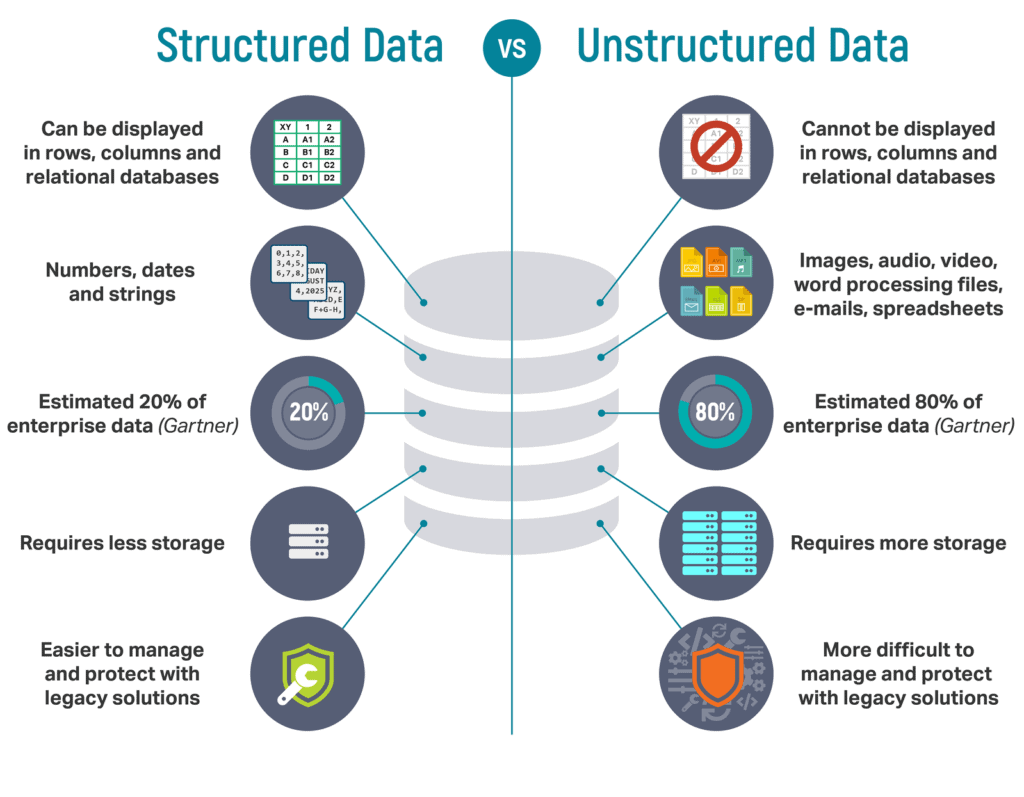Semi Structured Data
(2025-09-23T11:43.131Z)
Perplexity Query
(2025-09-23T11:43
.131Z)
Question:
Write a comprehensive one-page article about "Semi-Structured Data".
Model: sonar-pro
Semi-Structured Data: Bridging Structured and Unstructured Information
Semi-structured data is a type of data that does not conform to the rigid structure of traditional relational databases but still contains organizational properties such as tags or metadata to define and separate elements.
[cx9jj9]
[fxd56b]
Its importance lies in its ability to accommodate complex, variable, and diverse information that modern digital systems generate, making it indispensable for today’s data-driven enterprises.
[cx9jj9]

What Is Semi-Structured Data?
Unlike structured data—which fits neatly into tables—and unstructured data—which lacks any inherent organization, semi-structured data falls in between these two categories.
[fxd56b]
It is characterized by a flexible schema, meaning data records can differ in format or content while retaining some consistent structure.
[cx9jj9]
This adaptability makes semi-structured data highly scalable and able to reflect real-world complexity.
Common formats include JSON (JavaScript Object Notation), XML (eXtensible Markup Language), CSV, HTML, and formats used by NoSQL databases.
[cx9jj9]
[fxd56b]
For example, a JSON document storing user profiles might include a name and age for every person, but some profiles might also have fields for hobbies or addresses, and others might not.
[cx9jj9]
Practical Examples and Use Cases
Semi-structured data is ubiquitous:
- Log files and IoT sensor data: Logs and sensor outputs often come in semi-structured formats like JSON or CSV, with variable data according to device type and activity. [cx9jj9]
- NoSQL databases: These databases, such as MongoDB or Cassandra, are optimized for storing and querying flexible, semi-structured data from disparate sources. [fxd56b]
Organizations capitalize on semi-structured data for data integration, analytics, content management, customer behavior analysis, and more. For example, e-commerce companies parse website clickstreams or user-generated reviews in JSON format to enhance product recommendations and customer support.
[cx9jj9]
[uav5qw]
Benefits and Applications
Key advantages of semi-structured data include:
- Human readability: Formats like JSON and XML are accessible to both machines and humans.
- Scalability: Well-suited for rapidly growing data from online activities, IoT, and digital transformation. [cx9jj9]
This makes semi-structured data crucial for Real Time Analytics, Big Data processing, and Cloud Native applications.
[cx9jj9]
[fxd56b]
Its use spans finance (transaction logs), healthcare (medical records in XML), social media (user posts with tags), and logistics (Electronic Data Interchange for shipment information).
[uav5qw]
[3qaejq]
Challenges and Considerations
While flexible, semi-structured data can be complex to process:
- Variable schemas require specialized querying systems and sometimes manual data cleaning or transformation.
- Integration difficulties can arise when combining multiple sources with inconsistent structures.
- Performance issues may occur if improper storage or indexing strategies are used.
Nevertheless, modern tools—such as big data platforms and schema-on-read technologies—are evolving to address these hurdles.
[cx9jj9]

Current State and Trends
Adoption of semi-structured data formats is surging as businesses digitize workflows and embrace IoT, AI, and cloud technologies. Technologies like NoSQL databases (e.g., MongoDB, Couchbase), cloud data lakes (e.g., AWS S3, Azure Data Lake), and advanced analytics platforms drive this trend.
[fxd56b]
JSON and XML remain dominant, but newer frameworks like Parquet and Avro offer even greater efficiency for analytics workloads.
[cx9jj9]
Major players in tech—such as Google (BigQuery), Amazon (Redshift Spectrum), and Microsoft (Cosmos DB)—are investing in enhanced support for semi-structured and hybrid data management.
[cx9jj9]
[fxd56b]
Recent advances include automated schema inference, improved data visualization, and AI-driven data parsing.
[cx9jj9]
.png)
Future Outlook
The future will see even broader adoption of semi-structured data approaches, particularly as AI, machine learning, and IoT applications proliferate. Expect improvements in automated data normalization, hybrid query capabilities, and real-time stream processing.
[cx9jj9]
As digital transformation accelerates, the ability to harness and integrate complex, semi-structured sources will be vital for innovation and competitive advantage.
Semi-structured data is the backbone of modern information systems, enabling flexibility and scalability where traditional databases fall short. As digital content grows and data formats diversify, its role will only become more prominent in the data ecosystem.
Citations
[cx9jj9] 2025, Sep 23. Semi-Structured Data Explained: Benefits, Uses & Examples - Atlan. Published: 2024-10-29 | Updated: 2025-09-23
[fxd56b] 2025, Sep 19. Semi-Structured Data - Redis. Published: 2025-06-30 | Updated: 2025-09-19
[uav5qw] 2025, Jul 22. What Is Semi-Structured Data? (With Examples and Benefits) - Indeed. Published: 2025-06-06 | Updated: 2025-07-22
[j9vywu] 2025, Sep 22. What is Semi-Structured Data? - Teradata. Published: 2022-01-11 | Updated: 2025-09-22
[5]: 2025, Sep 20. Semi-Structured Data: Definition and Examples - Datamation. Published: 2023-11-30 | Updated: 2025-09-20
[3qaejq] 2025, Sep 23. What is Semi-Structured Data? Examples, Formats, and Charact. Published: 2024-09-27 | Updated: 2025-09-23
[7]: 2025, Sep 22. What is Semi-structured data? - GeeksforGeeks. Published: 2025-08-04 | Updated: 2025-09-22
[8]: 2025, Sep 23. What is semi-structured data? - CrowdStrike.com. Published: 2024-11-08 | Updated: 2025-09-23
[9]: 2024, Sep 05. What is Semi-Structured Data? - Simplilearn.com. Published: 2025-07-31 | Updated: 2024-09-05
[10]: 2025, Sep 23. What Is Structured, Semi-Structured and Unstructured Data?. Published: 2024-01-09 | Updated: 2025-09-23